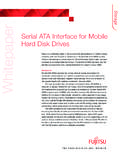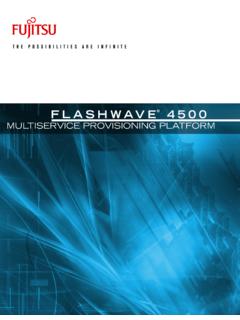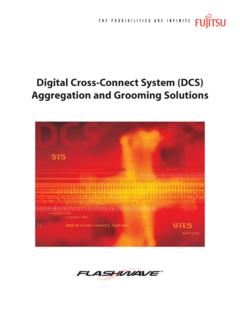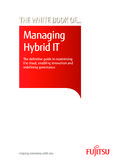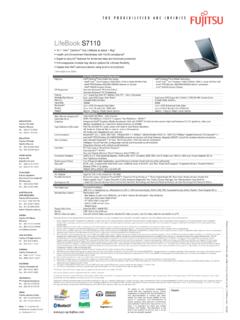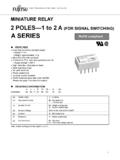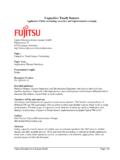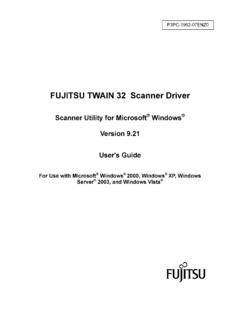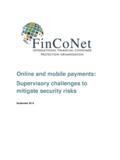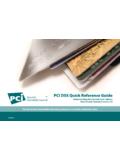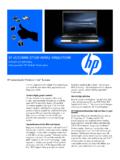Transcription of The Benefits of Cloud-RAN Architecture in Mobile …
1 Shaping tomorrow with youThe Benefits of Cloud-RAN Architecture in Mobile network ExpansionFUJITSU network COMMUNICATIONS Telecom Parkway, Richardson, Texas 75082-3515 Telephone: (888) 362-7763 seeking to accommodate smartphones and other data-heavy wireless devices in their networks face a key dilemma when it comes to expanding capacity and coverage. Fiber is typically the first option these operators think of when considering how to provide for exponential traffic growth. But fiber is expensive; it takes a long time to install, and in some locations it is not possible to install it at all. Thus, more and more operators are turning to wireless connectivity for a lower-cost, less complicated solution. Operators who choose wireless architectures have several options to choose from: small cells (SC-RAN); carrier Wi-Fi (CW-F); and Distributed Antenna System (DAS). These and a host of other solutions are being introduced by network operators as methods of expanding their network to accommodate data growth.
2 Alongside the question of network expansion , there are other business imperatives. Mobile data transport architectures must be evaluated based on characteristics such as agility; time to market; cost-effectiveness; operational and architectural simplicity; expandability; and flexibility. Energy consumption and physical size are also key factors in the development of new network Architecture ; power and space are expensive and scarce resources at base station sites and central offices. A Centralized-RAN, Cloud-RAN , or C-RAN Architecture addresses capacity and coverage issues, while supporting Mobile xHaul (Fronthaul and Backhaul) solutions as well as network self-optimization, self-configuration, self-adaptation with software control and management through SDN and NFV. cloud RAN also provides great Benefits in controlling ongoing operational costs, improving network security, network controllability, network agility and flexibility. Growth and expansion Challenges Global Mobile data traffic grew by a staggering 81% in 2013 alone and is expected to reach Exabytes (an Exabyte is one billion gigabytes) per month by 2018.
3 This is almost a tenfold increase in data traffic in just half a decade [1]. However, the spectrum available for network expansion is scarce, especially when combined with regulatory limits. The value of spectrum depends on a range of factors including the physical characteristics of the band; the geographical location; interference from neighboring bands; the timing of purchase; and the application of the spectrum. Spectrum is expensive and time-consuming to license; it takes years to clear the incumbent competition to obtain access. Wireless connectivity inherently enables nomadic customer behavior, and these transient data patterns make expansion difficult. Recent usage patterns suggest that data traffic is heavily concentrated around densely populated metropolitan areas, such as college campuses, sports venues, public transportation hubs, shopping complexes, healthcare facilities, and residential neighborhoods. A study conducted by the Pew Research Center indicates that more than 88% of the population in North American urban areas use either or both a smartphone and a tablet-type device; a little less than 40% of these people use these devices as their primary source of Internet access [2].
4 Mobile operators who intend to increase their coverage and capacity by setting up new base stations face an array of challenges. Infrastructure setup cost and operational expenses are high, since they include acquisition of real estate and sourcing of maintenance personnel. Environmental concerns and added regulations for special application requirements make it difficult to scale the network efficiently. The access costs of optical backhaul links from base station to core are high, and fiber installations are cumbersome in situations where the physical terrain is unsuitable for fiber existing wireless Mobile network infrastructure was originally designed to handle voice traffic; hence metropolitan Mobile networks are being overwhelmed by mounting data demand. With high-density networks, interference management and interoperability between vendors are both vital factors for customer experience and retention. Without significant upgrades and a long-term migration plan to service ongoing escalation in bandwidth demand, operators risk the loss of coveted high-margin, high-throughput Mobile business in data traffic also severely impacts power consumption, with consequent cost burdens.
5 Most of the power consumption is in the radio access networks, specifically at base stations. These consume more than 80% of the total power drawn by a typical Mobile network system [4]. Reducing energy cost and shrinking the carbon footprint to transform to an efficient power management paradigm are increasingly urgent imperatives, especially in combination with demand for increased capacity, better coverage, and all-time-high throughput. New and alternative techniques and architectures that favour efficient operation, low power consumption, agile traffic management, and high reliability are not just nice-to-haves; they are business Benefits of Cloud-RAN Architecture in Mobile network ExpansionArchitectures that favor efficient operation, lower power consumption, agile traffic management and high reliability are not just nice-to-haves; they are business network COMMUNICATIONS Telecom Parkway, Richardson, Texas 75082-3515 Telephone: (888) 362-7763 if all this pressure were not enough, technology trends in the wireless communication industry have been shifting for the past few years from current 3G technologies to more advanced 4G technologies like LTE and LTE-A.
6 This technology paradigm shift is creating a cost and implementation conundrum because in most cases, large network providers have been compelled to support multistandard networks. Even allowing for increased numbers of subscribers, revenue growth has been anemic. Despite subscriber growth of roughly 50% per year between 2008 and 2011, the communications industry only saw data revenue growth of 8% [3]. Players in this highly competitive industry face a daunting task with rising data usage and declining ARPUs. Installing advanced wireless equipment to increase coverage and capacity requires commitment to significant capital investment. In addition, it is also imperative to explore minimum-maintenance systems that reduce OpEx, as a means to maximize profit. Agile, flexible, scalable network solutions are essential to improve and sustain QoS and QoE for customers while generating substantial CapEx and OpEx savings. Mobile network expansion Options The challenges set forth in this paper mean that many operators are being compelled to resort to iterative schemes of network planning: adding new infrastructure and backhaul as needed to accommodate growing demand for capacity and coverage.
7 However, limited spectrum availability and the physical characteristics of radio waves will not allow a complete overhaul of the system beyond their capacity limits. It is challenging to meet demand for higher throughput in metropolitan areas with high volumes of users when faced with such restricted options for network expansion . Co-channel and adjacent channel interference between cell sites causes deterioration in the signal quality and hence, adversely affects user experience. In addition, the expensive optical fiber links needed to provide gigabit backhaul between base stations not only lack flexibility, they are time-consuming and sometimes impracticable to deploy. Mobile network operators who are already CapEx and OpEx constrained are understandably seeking affordable, easily deployable, scalable and agile alternatives for network expansion . An array of solutions are now available. A few relevant Mobile network expansion options merit particular repeater/relay is a non-intelligent system that blindly retransmits the signals it receives from an existing base station.
8 It is a simple and economical solution for extending coverage in blind-spot situations, and significantly reduces call drops in inferior coverage areas. Unfortunately, a repeater/relay-based solution also amplifies noise along with the signal before re-transmission. This causes the overall signal quality to deteriorate at every hop; this option is therefore not a viable Return On Investment (ROI) option in the long term. Distributed Antenna System (DAS)DAS provides a means of extending outdoor base station signals into indoor environments. DAS is a network of antennas separated spatially but receiving input from a common base station source. DAS uses multiple smaller antennas to cover the same area and provides deeper penetration and coverage inside buildings. RF input to the antennas can be carried either by lossy coax cables or more costly optical fiber lines. In-building, neutral-host DAS can support multiple operators and standards at various levels, but advanced equipment is needed to meet a wider range of frequency bands and power outputs.
9 Unwanted signal by-products and interference are still a cause for concern in a shared DAS. Some experts in the network planning and engineering business have remarked that DAS is not really scalable and any building up to about 30 floors is more suitable for small cell technology rather than DAS. Ownership of a DAS system between operators and building owners, coupled with the high cost of DAS antenna arrays with dedicated wiring inside a building, makes DAS inflexible and less attractive for large-scale deployment. Carrier Wi-Fi (CW-F)CW-F provides improved, scalable, robust unlicensed spectrum coverage and is often deployed as a standalone solution. CW-F is an easy data offload from the cellular networks with access and policy control capable of supporting large numbers of users. Wi-Fi with new standards, such as Hotspot , can provide high data rates for users who are continuously streaming content on Mobile devices. The Benefits of Cloud-RAN Architecture in Mobile network ExpansionRepeater/RelayCarrier Wi-Fi(CW-F)Small-Cell RAN(SC-RAN)DistributedAntennaSystem (DAS)FUJITSU network COMMUNICATIONS Telecom Parkway, Richardson, Texas 75082-3515 Telephone: (888) 362-7763 , a wireless communication research organization, has forecast revenue from CW-F as high as $ billion in 2017; this is anticipated to come mostly from data offload applications [5].
10 However, seamless integration of CW-F with other existing Mobile technologies still remains a challenge. Wi-Fi mobility and handoff needs to be enhanced to achieve guaranteed QoS in an unlicensed environment. Hence, CW-F does not offer viable ROI for most Mobile RAN (SC-RAN)SC-RAN provides a low-cost, scalable, self-organizing and effective solution to address some of the network expansion challenges already discussed. HetNets (Heterogeneous Networks) use a combination of technologies to provide a mixed- network deployment scenario. SC-RAN (which supports GSM, CDMA, UMTS/HSPA, LTE, LTE-A, and Wi-Fi standards) are low-power mini base stations that cover a range of 10 200 meters. SC-RAN is designed to provide higher throughput and better coverage in both indoor and outdoor environments. Innovative wireless backhaul and fronthaul techniques can enable small cells to deliver coverage in areas where wired links are challenging to deploy. cloud -based processing techniques can be implemented to centralize the baseband processing of multiple SC-RAN and improve inter-cell mobility and interference management.
